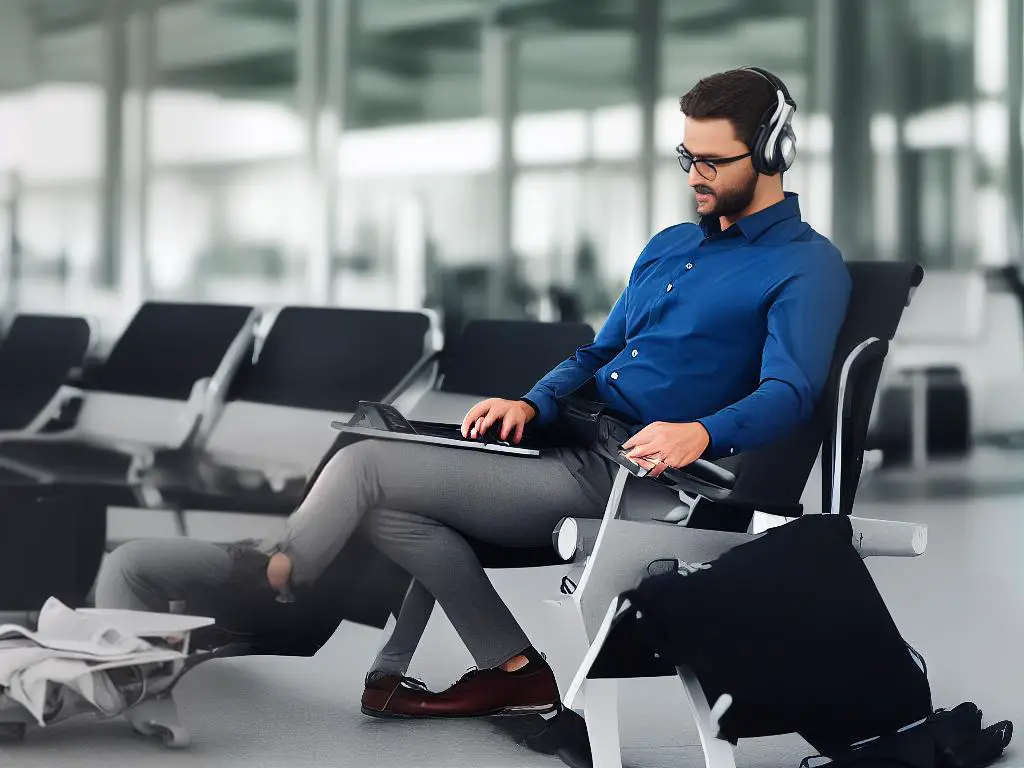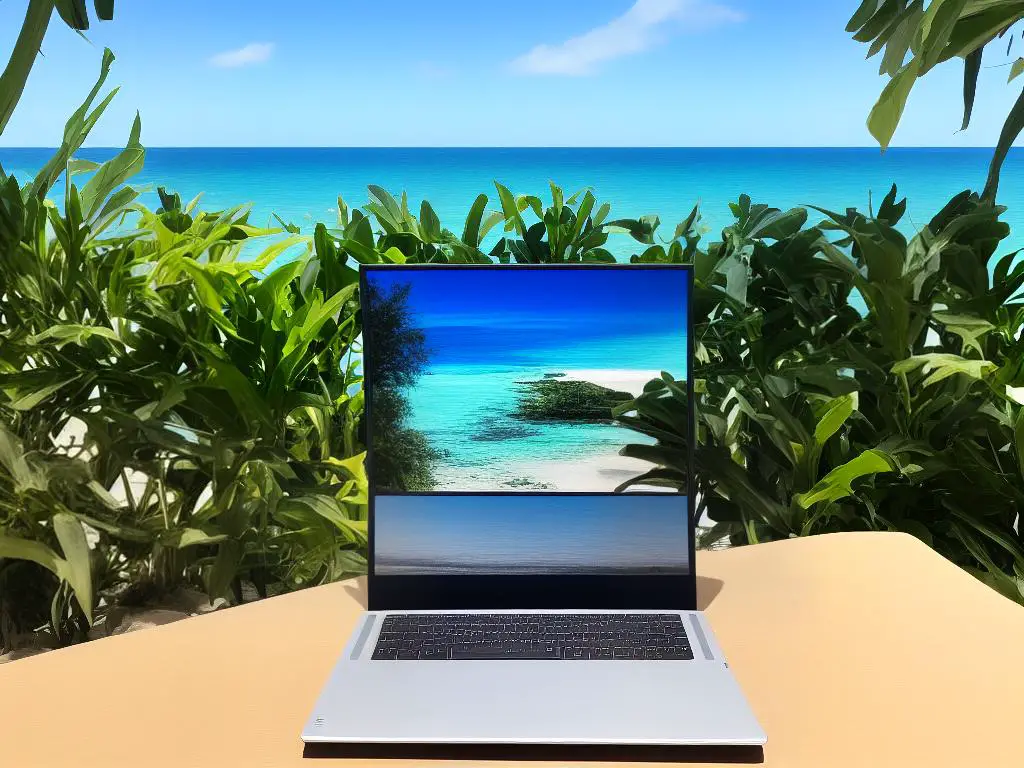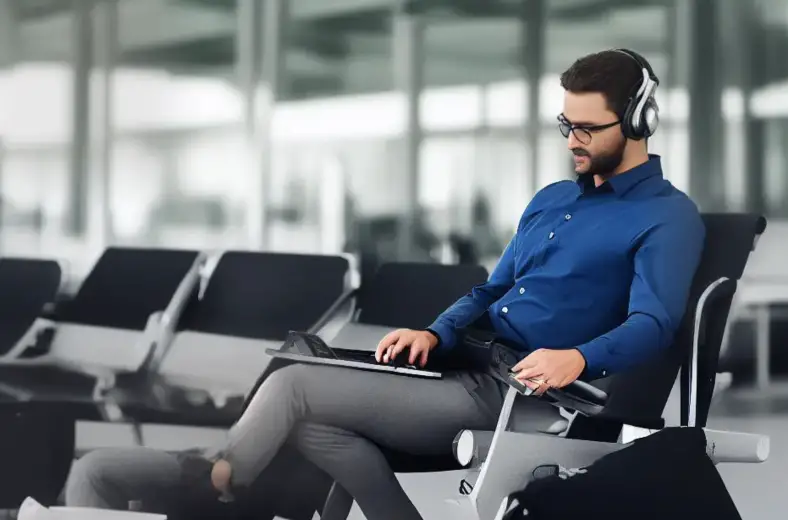Embarking on a journey with your laptop can be an exciting and convenient way to work or stay connected while exploring new destinations. This guide will help you navigate every aspect of traveling with a laptop, from selecting the perfect device to ensuring your data stays safe and secure. Equip yourself with essential knowledge on internet connectivity, laptop maintenance, and even balancing work and leisure to make the most of your travels.
Choosing the right laptop for travel
Traveling for either pleasure or business means you may need a reliable portable computer for your on-the-go lifestyle. The right laptop should be able to handle all your computing needs without adding extra weight to your luggage. This guide will help you learn about different laptop models, their weight, battery life, performance, and why these factors matter for travel.
Step 1: Determine your travel needs
It is essential to identify what tasks you’ll be doing while traveling. Will you use the laptop for casual web browsing, work presentations, or heavy video editing? Knowing the purpose of your device will help you decide on what kind of laptop is suitable for your needs.
Step 2: Research different laptop models
There are various types of laptops available on the market, ranging from lightweight, ultra-portable devices to more powerful, bulky machines. Consider the following types of laptops:
- Ultrabooks: These are thin and lightweight laptops with long battery life and quick boot-up times but may be less powerful than other options. They are ideal for travelers who need their device to be as portable as possible.
- 2-in-1 laptops: These convertible laptops can function as both a laptop and a tablet, providing flexibility for travelers who want to use their device in various situations, like work presentations and relaxation.
- Gaming laptops: These are built to handle high-performance computing needs, like gaming or video editing. They can be bulkier and have shorter battery life, but are a good option if you require more processing power.
Step 3: Consider the weight of the laptop
Since you’ll be carrying your laptop as you travel, it is essential to choose a device that is light enough to bring without adding too much strain to your luggage. Aim for a laptop weighing between 2-4 pounds if portability is your top priority.
Step 4: Evaluate the battery life
Battery life is crucial when traveling, as you may not always have an available power source. Aim for a laptop with at least 8 hours of battery life on a single charge to ensure that your device stays powered throughout your day.
Step 5: Analyze the performance
The performance of your laptop is determined by its processor, RAM, and storage. Choose a laptop that has a processor suitable for your needs, whether it be energy-efficient for light tasks or powerful for demanding tasks. Additionally, look for a laptop with at least 8GB RAM and at least 256GB storage to handle multiple applications and store your files.
Step 6: Don’t forget about the ports
Ensure that your laptop has the necessary ports, such as USB, HDMI, and SD card slots to connect to your other devices, like smartphones or projectors. This is especially important if you are traveling for work and need to connect to other devices for presentations.
Step 7: Compare costs and warranties
Finally, compare the costs of different laptop models and also consider any available warranties. Traveling can put extra stress on your device, so ensuring that your laptop has a solid warranty can provide peace of mind while you’re on the go.
By considering your travel needs, laptop model options, weight, battery life, performance, and ports, you can make an informed decision on the right laptop for your travels. With the perfect laptop in hand, you’ll be ready to take on any adventure without compromising your productivity and connectivity.

Photo by christinhumephoto on Unsplash
Packing essentials for a digital nomad
Traveling with a laptop can be a game-changer, as it allows you to work on the go, stay connected, and access all of your important files. However, it can also pose some challenges, such as finding the right balance between packing light and having everything you need. In this guide, we will cover some essential items that every digital nomad should consider bringing along when traveling with a laptop.
Choose a durable and protective laptop case or backpack
- Opt for a case that is water-resistant and offers ample padding to protect your laptop from bumps and scratches
- Consider a backpack with a designated laptop compartment for added security and convenience
- Look for additional storage compartments for your peripherals such as chargers, USB drives, and external hard drives
Bring a power adapter with international compatibility
- Research the type of power outlets used in your destination and pack the appropriate adapter
- Consider a universal travel adapter with built-in surge protection to cover multiple countries
- Always have at least one spare power adapter in case one gets lost or broken
Invest in a reliable external hard drive for file storage and backups
- Opt for at least 1TB of storage capacity to ensure that you have enough space for all your files and projects
- Choose a portable hard drive that is lightweight, durable, and offers fast transfer speeds
- Regularly back up your files while traveling to avoid data loss
Pack essential accessories and peripherals
- Bring a comfortable and portable mouse and keyboard for added convenience while working
- Consider a compact USB hub for connecting multiple devices to your laptop
- Don’t forget your charging cables, earbuds, and a portable phone charger
Plan for internet connectivity
- Investigate local Wi-Fi options or invest in a portable Wi-Fi hotspot for reliable internet access
- Tether your laptop to your smartphone’s data plan when a Wi-Fi connection is not available (keep in mind the roaming charges and data limits)
- Use a VPN (Virtual Private Network) to ensure safe and secure browsing
Keep your devices organized and accessible
- Utilize cable organizers or zippered pouches to keep all of your cords, chargers, and small accessories organized
- Label your cables and chargers for easy identification
- Store essential items in easily accessible compartments within your laptop bag or backpack
Traveling with your laptop can be a liberating experience for digital nomads, but it also requires careful planning and organization. By investing in high-quality gear, regularly backing up your data, and staying connected, you can ensure that your travels are productive and enjoyable. Happy travels!

Securing your laptop and data
Purchase a laptop case or bag: Invest in a sturdy, well-padded laptop case or bag that can help protect your laptop from physical damage during your travels. Look for a bag with multiple compartments for storing the laptop, its accessories, and your personal items. A case with a combination lock or secure zippers can add an extra level of security.Enable a strong password or passphrase: Secure your laptop with a strong and unique password or passphrase. Make sure it contains a combination of upper and lowercase letters, numbers, and special characters. Avoid using your birthdate, family members’ names, or other easily guessable information. Update your password periodically, especially before traveling.Set up multi-factor authentication: Multi-factor authentication (MFA) adds an extra layer of security by requiring two or more forms of validation to access your laptop. This includes something you know (your password), something you have (a physical or digital token), and/or something you are (such as a fingerprint). Enable MFA whenever possible for greater protection.Enable location tracking: In case your laptop is lost or stolen, enable location tracking to help locate the device. There are various pre-installed applications like “Find My Device” on Windows and “Find My Mac” on macOS that can help track your laptop’s location. Always have the device tracking software set up and activated.Encrypt your data: Encrypting your data ensures that it can only be accessed by someone with the proper encryption key. Use an encryption software like BitLocker for Windows or FileVault for macOS to keep your data secure. This will make it much more difficult for unauthorized users to access your sensitive information.Use Virtual Private Networks (VPNs): A VPN allows you to securely access the internet over public Wi-Fi networks and helps protect your data from potential attackers. Before traveling, research and select a reputable VPN service to use while away. Always turn on the VPN when connecting to public Wi-Fi networks.Maintain up-to-date antivirus software: Keep your laptop’s antivirus software updated to protect against the latest viruses and malware. Ensure that you have the most recent version of the software installed and run regular scans to detect and remove any potential threats.Back up your files: Regularly back up all important files and documents on your laptop. You can use an external hard drive, cloud storage services, or a combination of both to ensure your data is well-protected. If your laptop is lost, stolen, or damaged, having backup copies of your data will make it easier to recover.Make a physical record of your laptop’s information: Document your laptop’s make, model, serial number, and any other identifying information that could be useful in case of theft. Store this information in a safe place, separate from your laptop, and consider taking a photo of the information as well.Be aware of your surroundings: When traveling with your laptop, always remain vigilant about your surroundings. Keep your laptop within your sight at all times, and never leave it unattended in public places. When going through airport security checkpoints, ensure that you keep an eye on your laptop and retrieve it as soon as possible after it passes through the x-ray machine.

Internet connectivity and VPN usage
Internet Connectivity Options While Traveling
- Public Wi-Fi networks:
- Airports, coffee shops, hotels, and libraries usually offer free public Wi-Fi.
- Always check the legitimacy of the network before connecting.
- Avoid sensitive tasks like online banking on these networks due to potential security risks.
- Mobile hotspots:
- Create a personal Wi-Fi network by using your smartphone’s data connection (tethering).
- Ensure that you have a sufficient data plan and coverage to avoid high charges.
- Encrypt your mobile hotspot with a strong password for added security.
- Portable Wi-Fi devices:
- Rent or purchase a portable Wi-Fi hotspot device for dedicated connectivity.
- Research options for supported countries and data plans before your trip.
- Remember that these devices may have limited battery life and should be charged regularly.
- Local SIM cards:
- Unlocked devices can use international or local SIM cards with a data plan.
- Prepaid SIM cards are available in most countries and should be researched beforehand.
- Rates and connectivity options vary depending on the carrier and country.
Using a VPN to Secure Your Connection
- Understand what a VPN does:
- A VPN creates an encrypted connection between your device and a VPN server.
- Protects your data from being intercepted by hackers and identity thieves.
- Conceals your IP address and location for increased privacy.
- Choose a reputable VPN provider:
- Research the level of encryption, privacy policies, and server locations.
- Opt for a paid VPN service to ensure reliability, support, and features.
- Read user reviews and consult expert recommendations for the best options.
- Set up your VPN on your laptop:
- Download and install the VPN software provided by your chosen provider.
- Enter your login credentials and adjust settings according to your preferences.
- Choose a VPN server location based on your needs (e.g., access geo-restricted content by selecting a server in that country).
- Connect to the internet using your VPN:
- Once connected to the internet, start your VPN software and connect to a server.
- Verify that the VPN connection is active by checking your IP address online.
- Surf the web, conduct your sensitive tasks, and enjoy a secure connection!

Laptop maintenance and battery care
Traveling with a laptop can be a great way to stay productive and entertained. Proper maintenance, battery care, and cleaning can ensure that your laptop runs smoothly throughout your travels. Here are some tips:
Laptop Maintenance:
- Keep your laptop cool
- Update software regularly
- Back up your data
- Use antivirus software
Battery Care:
- Limit power-hungry applications
- Adjust power settings
- Unplug peripherals when not in use
- Charge your laptop correctly
Laptop Cleaning:
- Clean the screen
- Remove dust and dirt
- Clean the keyboard
- Wipe the laptop’s exterior
These easy tips will help keep your laptop in good condition while on the go. Taking care of your laptop is important, so that it can remain a useful tool for productivity and entertainment throughout your travels. Have a safe and happy trip!

Navigating airports and customs with a laptop
Research airline and TSA guidelines: The first step in traveling with a laptop is to familiarize yourself with the specific guidelines and policies of both the airline you’ll be flying on and the Transportation Security Administration (TSA). These can typically be found on each organization’s website, and may include guidelines on laptop size, weight, and specific electronics restrictions.Pack your laptop properly: To ensure the safety of your laptop, it’s important to pack it securely. Consider investing in a high-quality laptop case or sleeve to protect it from damage during your travels. Additionally, avoid packing it in a checked bag to minimize the risk of theft or damage. Always place your laptop in your carry-on bag and follow the airline’s guidelines regarding the size and weight restrictions.Bring necessary accessories: Make sure to pack all necessary laptop accessories, such as power cables, chargers, and adapters for international plugs. Many countries have different power standards, so ensure you have the correct adapters before you go.Prepare your laptop for security checkpoints: Before passing through a security checkpoint, you may be required to remove your laptop from its case or sleeve, as well as any accessories that may be attached to it. Be prepared by making sure your laptop is easily accessible in your carry-on bag.Navigate TSA security checkpoints: When approaching a TSA security checkpoint, be prepared to show your boarding pass and a valid government-issued identification. Follow the TSA officer’s instructions and remove your laptop from its case or sleeve, placing it in a separate bin for scanning. Remember to collect your laptop after passing through the X-ray machine, and put it back into its case or sleeve.Understand customs requirements: If you’re traveling internationally, be aware of the customs regulations in the countries you’re visiting. Be prepared to answer questions about your laptop, and provide documentation if asked about your ownership or the contents of your device. Some countries may also inspect your laptop to ensure that it does not contain any prohibited information or material.Declare your laptop on entry and exit forms: Depending on your destination, you may be required to declare your laptop on entry or exit forms. Familiarize yourself with the forms and make sure to complete them accurately. Be prepared to pay duties or taxes if applicable, and always be honest about the value of your laptop and any other items you’re carrying.Be mindful of air travel etiquette: While using your laptop on a flight, be mindful of your fellow passengers. Use headphones to keep noise levels low, and avoid using your laptop during takeoff and landing or when the seatbelt sign is on. Be respectful of personal space and avoid disturbing those seated close to you.Keep your laptop secure while traveling: Always keep your laptop with you while traveling, and avoid leaving it unattended in public places. If you must leave your laptop in your hotel room, make use of the in-room safe or ask the hotel front desk about securing your belongings.Be prepared for emergencies: Ensure that your laptop has updated antivirus software installed and create a backup of important files before traveling. In case of theft, loss, or damage, having these precautions in place can minimize stress and make it easier to recover your information.

Laptop-friendly travel accessories
Traveling with a laptop doesn’t have to be a hassle if you have the right accessories on hand. In this guide, we will discuss some of the most useful travel accessories designed specifically for laptop users. These accessories will make working on the go more comfortable, efficient, and enjoyable. From ergonomic travel keyboards to portable stands and cooling pads, we’ve got you covered!
Ergonomic Travel Keyboards:
When you’re using your laptop for an extended period while traveling, having a comfortable keyboard is vital. Consider investing in an ergonomic travel keyboard that provides a more natural typing position to prevent wrist strain and fatigue. Look for features such as:
- Compact and lightweight design for easy packing
- Foldable or rollable options to save space
- Wireless connectivity for a clutter-free setup
- Built-in touchpad or trackball for easy mouse control
- Adjustable angles and heights for personalized comfort
Some popular ergonomic travel keyboard options include the iClever BK03 Foldable Bluetooth Keyboard and the Logitech K380 Multi-Device Bluetooth Keyboard.
Portable Laptop Stands:
A portable laptop stand can improve your posture and overall comfort while working on your laptop. These portable stands elevate your laptop to a more ergonomic height, allowing you to maintain a better posture while typing. Look for features such as:
- Lightweight and foldable design for easy packing
- Adjustable heights and angles to suit your preferences
- Ventilated surface to prevent your laptop from overheating
- Non-slip pads to keep your laptop stable and secure
- Compatible with various laptop sizes
Some popular portable laptop stand options include the Roost Laptop Stand and the Nexstand K2 Laptop Stand.
Laptop Cooling Pads:
Laptop cooling pads are essential for keeping your laptop’s temperature in check, especially while using it for extended periods. These cooling pads are typically equipped with fans to disperse heat and ensure your laptop’s components stay within a safe temperature range. Look for features such as:
- Slim and lightweight design for easy packing
- Multiple cooling fans for efficient heat dissipation
- Adjustable fan speed to suit your laptop’s needs
- USB-powered for convenience
- Non-slip surface to keep your laptop secure
Some popular laptop cooling pad options include the Havit HV-F2056 Laptop Cooling Pad and the Cooler Master NotePal X-Slim.
Traveling with a laptop can be a breeze when you invest in the right accessories. Ergonomic travel keyboards, portable laptop stands, and cooling pads are just a few of the must-have items that will make your work on the go experience more enjoyable and efficient. So, whether you’re a digital nomad or just taking your work with you on vacation, consider picking up some of these accessories for a seamless and comfortable laptop-using experience. Safe travels, and happy typing!”

Balancing work and leisure while traveling
Balancing Work and Leisure While Traveling with a Laptop
Traveling with a laptop can be both exciting and challenging, as it allows you to work flexibly and explore new destinations simultaneously. The key to achieving a balance between work and leisure while traveling is effective time management, finding ideal workspaces, and ensuring that you make the best use of your opportunities to explore new places. Below are some strategies to help you balance work and leisure while traveling with a laptop.
1. Set goals and priorities
Before you begin your trip, make a list of your work-related tasks and prioritize them according to their importance and deadlines. Also, create a separate list of the places you want to visit and the activities you want to engage in during your leisure time. This will help you stay organized and focused on what needs to be done.
2. Create a daily schedule
To find the balance between work and leisure, create a daily schedule that allocates specific hours to work and leisure activities. You may want to complete work tasks during the morning or evening, leaving the rest of the day open for exploration and relaxation. Stick to your schedule as much as possible to ensure you get both work and leisure done.
3. Utilize time on transport
While traveling from one destination to another, make use of your time on trains, buses, or planes to get some work done. This can help you stay productive and save time for leisure activities once you arrive at your destination.
4. Find ideal workspaces
Look for spaces that are suitable for working, such as hotel rooms, co-working spaces, coffee shops, or libraries. Make sure that your workspace has access to a strong Wi-Fi connection, comfortable seating, and minimal distractions. If you find a great workspace, consider spending several hours working there to maximize your productivity.
5. Set boundaries and communicate with others
If you are traveling with friends or family, let them know about your work schedule and the importance of sticking to it. Setting boundaries and asking for their understanding and support will help ensure that you have the space and time you need to focus on your work.
6. Learn to be adaptable
While traveling, you may face unexpected situations, such as Wi-Fi outages or travel delays. Be prepared to adapt your plans and work schedule when necessary. Stay flexible and find alternative ways to get your work done.
7. Make use of technology
Utilize productivity apps, project management tools, and communication platforms to stay organized and connected with your team or clients. These tools will help you stay on top of your work and communicate effectively, regardless of where you are.
8. Take breaks and stay healthy
It can be easy to overwork yourself while traveling, but it’s essential to take breaks and maintain a healthy balance. Schedule time for exercise, healthy meals, and sleep to ensure you remain energized and focused throughout your trip.
9. Indulge in local experiences
When you have free time, make an effort to explore your destination and engage in local experiences. This will provide a balance between your work and leisure time and make your trip more fulfilling.
10. Reflect and adjust
Monitor your progress regularly and assess whether you are maintaining a good balance between work and leisure. If needed, make adjustments to your schedule or priorities to achieve a better equilibrium.
By implementing these strategies, you can successfully balance work and leisure while traveling with a laptop, ensuring that you remain productive and make the most of your exciting new destinations.

Armed with these valuable insights, you can confidently traverse the globe with your trusty laptop in tow. Whether you’re a digital nomad looking for the best travel accessories or a leisure traveler interested in staying connected and securing your data, this comprehensive guide ensures smooth sailing through your digital and physical journeys, making the most of your time spent abroad. Safe travels and happy computing!
